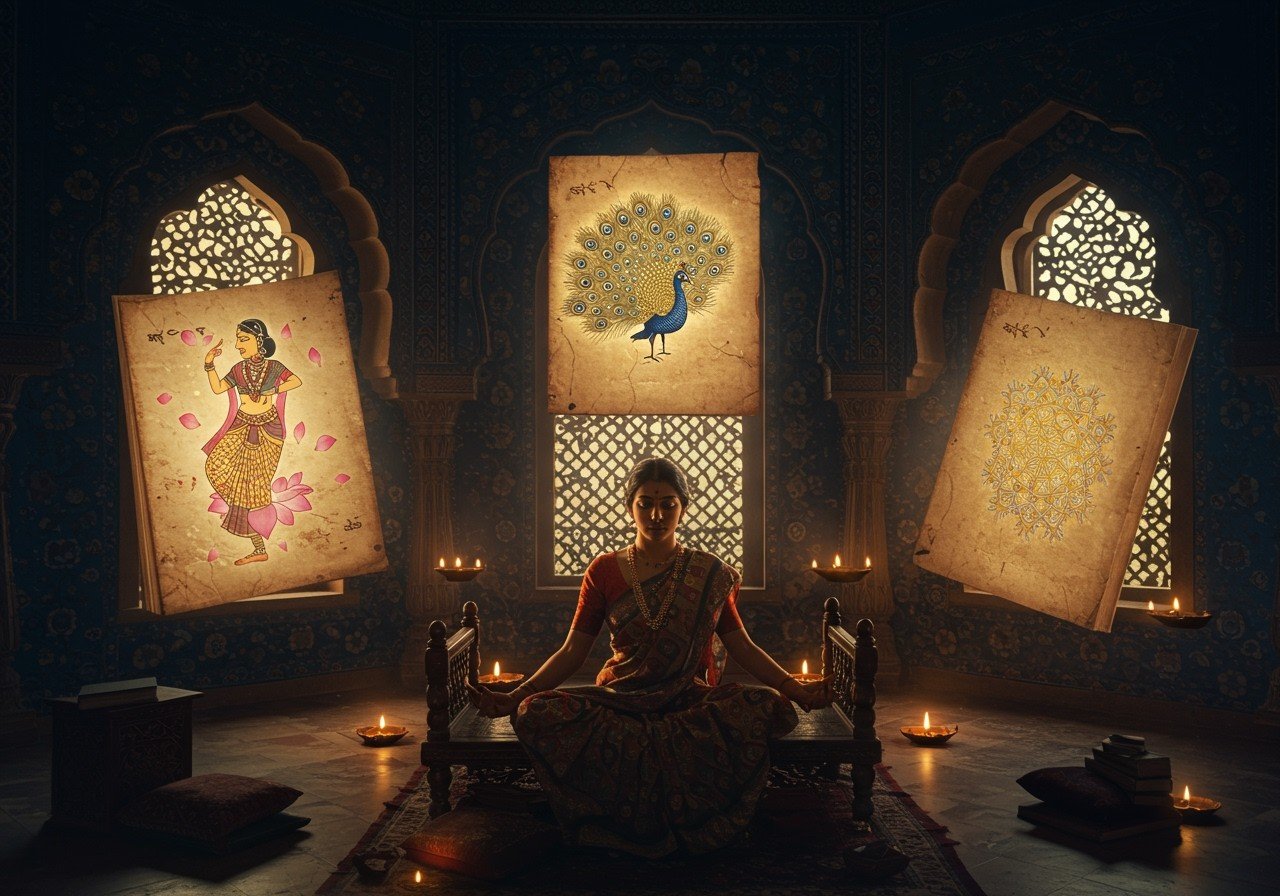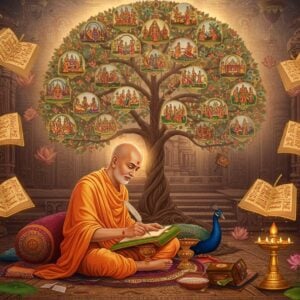
Indian aesthetics hold a deep influence on our literature, weaving together history, culture, and philosophy. These principles have shaped themes, narratives, and styles in Indian literature for centuries. Concepts like rasa (essence), dhvani (suggestion), and alamkara (ornamentation) are significant in both creating and critiquing literary works. Today, these aesthetics continue to resonate in modern literature, enriching our understanding and appreciation of storytelling.
Exploring the Core Principles
The foundational texts of Indian aesthetics have deeply influenced literary creation. The Natya Shastra, an ancient Indian treatise on performing arts, introduces the concept of rasa, which impacts literature by defining the emotional essence of a story. It provides a framework for understanding how art evokes emotions in the audience. Another key text, the Dhvanyaloka by Anandavardhana, establishes the theory of dhvani, focusing on suggestion and its application in poetry and prose. Dhvani adds layers of meaning, allowing readers to engage with the text on multiple levels. The Alamkara Shastra highlights literary embellishments that enhance the beauty of literary works. These ornaments add richness and depth to the language, making the experience more immersive for the reader.
Classical Examples and Modern Resonance
Classical Indian literature beautifully embodies these aesthetic principles. Let’s delve into some specific examples:
- Kalidasa’s works, renowned for their lyrical beauty and evocative imagery, masterfully employ rasa to evoke a spectrum of emotions in the reader, from the pangs of love to the joys of wonder. Consider Abhijnanashakuntalam, where the rasa of love (Shringara) is palpable.
- Bharavi’s poetry, known for its intellectual depth and complex metaphors, skillfully utilizes dhvani, creating layers of meaning that invite contemplation and deeper understanding. His Kiratarjuniya is a prime example of this nuanced approach to storytelling.
- Bhavabhuti’s plays, celebrated for their dramatic intensity and powerful dialogues, showcase the ornate expressions of alankara, adding a layer of richness and grandeur to the narrative. Uttararamacharita showcases his command of language and dramatic expression.
These texts and authors offer invaluable insights into how aesthetics elevate storytelling in Indian literature, making it a profound and enriching experience.
Delving Deeper into Rasa: The Heart of Indian Aesthetics
Rasa theory, a cornerstone of Indian aesthetics, delves into the emotional impact of art. Originating from Bharata’s Natya Shastra, rasa describes the “flavor” or essence that a work evokes in its audience, creating a deep and resonant experience. Think of it as the emotional echo that stays with you long after you’ve finished a book or watched a play.
Nine primary rasas form the core of this theory, each representing a distinct emotional state:
- Shringara (Love): This rasa captures the essence of romantic love, longing, and attraction, often portrayed through delicate imagery and passionate expressions.
- Hasya (Laughter): Evoking mirth and amusement, hasya uses wit, humor, and playful situations to lighten the mood and bring joy to the audience.
- Karuna (Compassion): Karuna evokes empathy and sadness, often depicting scenes of suffering or loss, prompting reflection on the human condition.
- Raudra (Anger): This rasa portrays fury and indignation, often associated with themes of injustice or betrayal, creating a sense of tension and drama.
- Veera (Heroism): Veera celebrates courage, valor, and noble deeds, often depicted through characters who overcome obstacles and embody strength.
- Bhayanaka (Fear): This rasa instills a sense of dread and apprehension, often through suspenseful narratives and eerie imagery, creating a thrilling experience.
- Bibhatsa (Disgust): Bibhatsa evokes revulsion or aversion, typically through depictions of unpleasant or grotesque elements, prompting reflection on the darker aspects of life.
- Adbhuta (Wonder): This rasa captures the sense of awe and amazement, often associated with the supernatural or extraordinary events, evoking a sense of childlike wonder.
- Shanta (Peace): Shanta represents tranquility and serenity, often depicted through peaceful landscapes or meditative states, promoting a sense of inner calm.
These rasas aren’t merely labels for emotions; they represent complex aesthetic experiences that resonate deeply with audiences, shaping their understanding and appreciation of art.
Connecting with Tradition through Poojn.in
At Poojn.in, we understand the deep connection between Indian aesthetics, literature, and spirituality. We offer a wide range of authentic puja items that can enrich your engagement with these traditions. Enhance your spiritual practices and create a sacred space for reflection with our curated collection:
- Sacred Texts and Accessories: Deepen your understanding of ancient scriptures with our collection of Bhagavad Gitas like this one, accompanied by detailed commentaries. Display them with reverence on traditional brass book stands or handcrafted wooden manuscript holders, creating a dedicated space for study and contemplation.
- Deity Idols Featured in Literature: Bring the stories to life with beautifully crafted deity idols. Find Lord Krishna statues in various poses described in classical poetry, Lord Shiva idols reflecting His cosmic dance (Tandava), and Goddess Saraswati murtis, the deity of knowledge and arts. These idols serve as a visual reminder of the rich narratives that have shaped our culture.
- Ritual Items for Literary Practices: Enhance your reading or study sessions with traditional ritual items. Light a brass oil lamp (diya) to illuminate your space and create a serene atmosphere. Use incense holders with traditional designs to purify the air and enhance focus. Perform Saraswati Puja with a special puja thali to invoke blessings for knowledge and creativity.
You can explore our extensive collection of authentic items and conveniently purchase them online with pan-India delivery. Our dedicated customer service team is available to guide you in selecting the most suitable items, ensuring a personalized and meaningful experience. Reach us at 03369029784 or WhatsApp us at 9476142738 for personalized assistance.
Visit www.poojn.in today to discover how our products can connect you with the rich traditions of Indian literature and spirituality. All our products come with authenticity certificates and are carefully packaged to ensure safe delivery.
Frequently Asked Questions about Indian Aesthetics in Literature
What is the significance of Indian aesthetics in literature? Indian aesthetics provide a unique lens through which we can appreciate and interpret literature, understanding the emotional and philosophical depths embedded within the narratives. It’s not just about the story itself, but the way it resonates with our deepest emotions and cultural values.
How do these principles influence modern Indian writing? While contemporary literature may explore new themes and styles, the underlying principles of Indian aesthetics continue to exert a subtle yet profound influence. The emphasis on emotional resonance, suggestive meaning, and the exploration of universal truths remains a hallmark of Indian writing, connecting us to our rich literary heritage.
Where can I learn more about these concepts? For those eager to delve deeper, numerous resources are available. Explore scholarly articles and books on Indian aesthetics, focusing on rasa, dhvani, and alankara. Online platforms also offer insightful discussions and analyses of these concepts, making them accessible to a wider audience.
For a practical understanding, immerse yourself in the works of classical Indian authors like Kalidasa, Bharavi, and Bhavabhuti. Their writings offer a direct experience of how these aesthetics come to life, enriching your appreciation of Indian literature.


